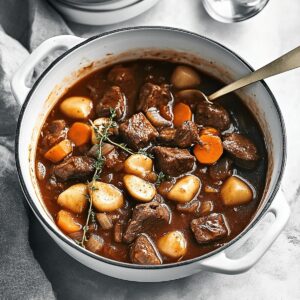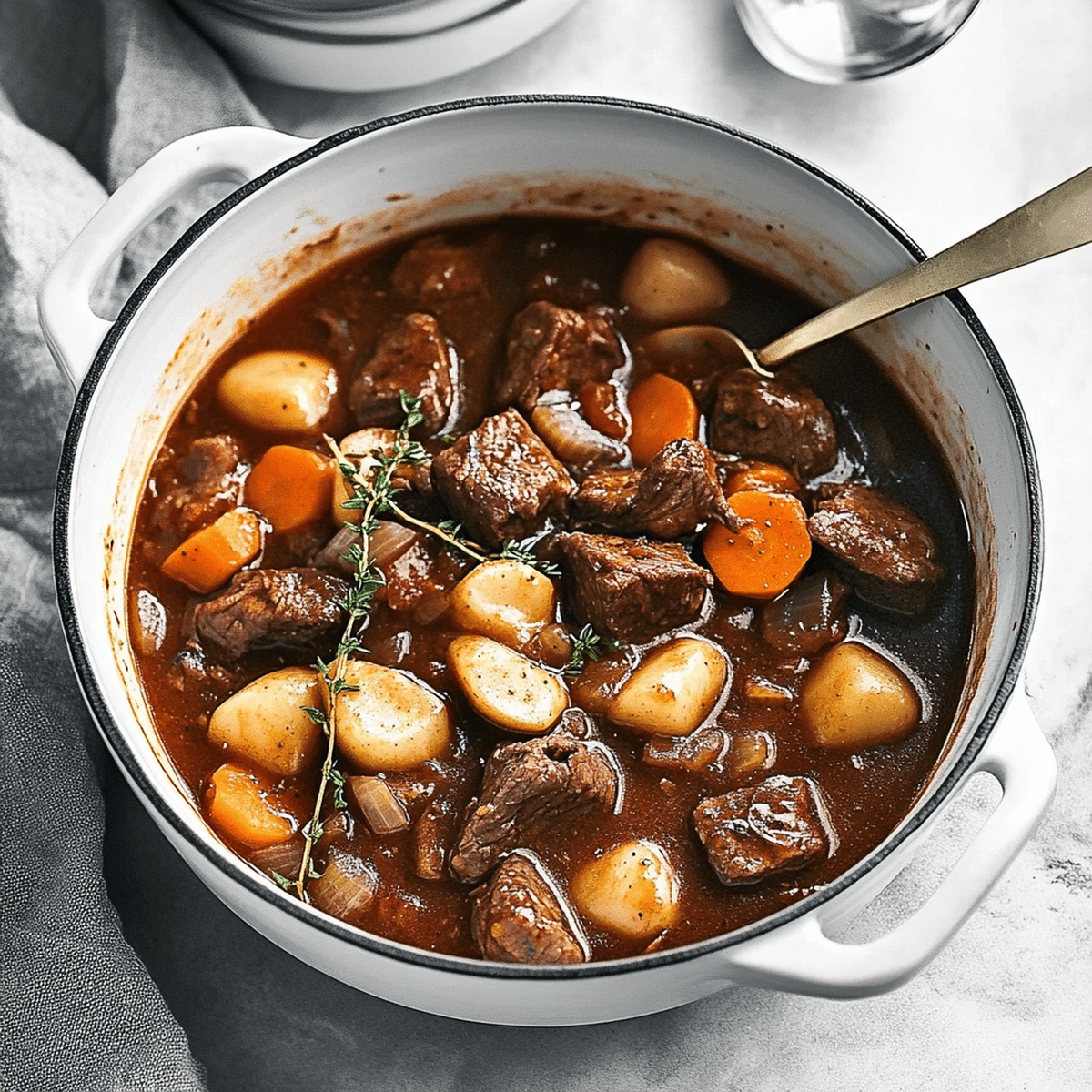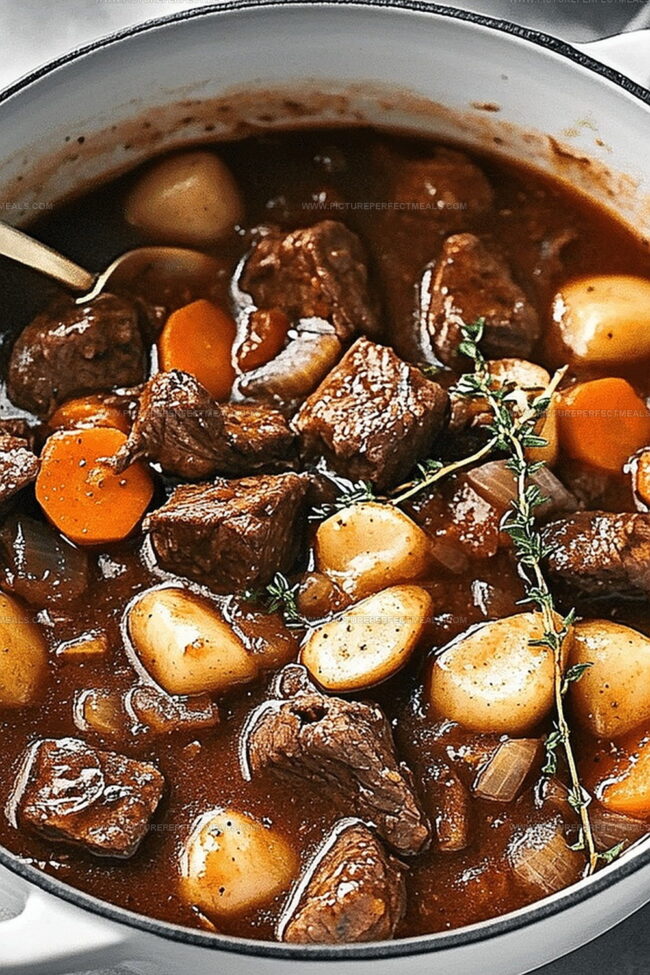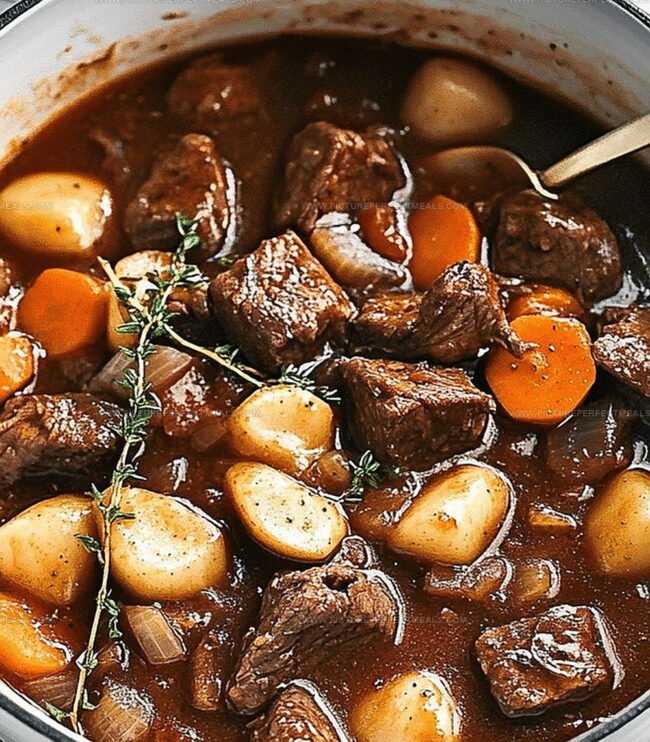Hearty Classic Beef Stew Recipe: A Comforting One-Pot Wonder
Years of culinary exploration led me to discover this hearty classic beef stew that promises comfort in every spoonful.
Memories of my grandmother’s kitchen inspire each carefully chosen ingredient.
Tender chunks of meat slowly simmer with robust root vegetables, creating a deeply satisfying meal.
Rich aromas fill the kitchen, promising warmth and nourishment.
Rustic and unpretentious, this stew speaks to simple, soul-warming cooking techniques passed down through generations.
Weeknight dinners or leisurely weekend meals become extraordinary with this one-pot wonder.
Why Classic Beef Stew Is Always in Season
What Goes into Classic Beef Stew
Protein Base:Aromatics and Flavor Enhancers:Herbs and Seasonings:Liquid and Cooking Base:Vegetables:Garnish:Let’s Make Classic Beef Stew from Scratch
Step 1: Prepare Beef Cubes
Grab your beef and pat each cube completely dry with paper towels. Toss the cubes into a mixing bowl and sprinkle with flour, salt, and pepper. Ensure every piece gets an even, light coating.
Step 2: Sear Meat
Heat olive oil in a large Dutch oven over medium-high heat. Carefully place beef pieces into the hot pot, creating a single layer. Brown each side until a rich golden crust forms. Work in batches to prevent overcrowding. Transfer seared meat to a separate plate.
Step 3: Create Flavor Base
Reduce heat to medium. Drop chopped onions and minced garlic into the same pot. Stir and cook until they become soft and release a wonderful aroma.
Step 4: Build Depth
Stir tomato paste into the pot and cook briefly. Pour red wine and scrape all delicious browned bits from the bottom. Let the liquid simmer and reduce slightly.
Step 5: Construct Stew
Return seared beef to the pot. Add:Bring mixture to a boil, then lower to a gentle simmer. Cover and cook slowly for 1-2 hours, stirring occasionally.
Step 6: Incorporate Vegetables
Mix in:Continue simmering covered for 30-40 minutes until meat and vegetables become wonderfully tender.
Step 7: Final Touches
Stir in peas during the last 5 minutes. Remove bay leaves. Taste and adjust seasoning with salt and pepper.
Step 8: Serve and Enjoy
Sprinkle fresh parsley on top. Serve piping hot alongside crusty bread or creamy mashed potatoes.
Pointers for the Best Classic Beef Stew
Best Ways to Keep Classic Beef Stew Fresh
Serve Classic Beef Stew with These Additions
Classic Beef Stew Variations You’ll Want to Try
Classic Beef Stew: What People Usually Ask
Patting the beef dry helps create a better sear and allows the flour to stick more evenly, creating a nice golden crust that adds flavor and helps thicken the stew.
While beef is traditional, you can substitute with lamb or venison for a similar hearty stew that follows the same cooking method.
Dried herbs work perfectly fine. Use about 1/3 of the amount of dried herbs compared to fresh, as dried herbs are more concentrated in flavor.
The beef should have a deep golden-brown color on all sides. This process called searing creates rich, caramelized flavors that are crucial to the stew’s depth.
Print
Classic Beef Stew Recipe
- Total Time: 2 hours 15 minutes
- Yield: 6 1x
Description
Hearty classic beef stew delivers comfort with tender meat and rich, velvety sauce simmered slowly to perfection. Warm spices and root vegetables promise a satisfying meal that connects home cooks with timeless culinary traditions.
Ingredients
Meat & Vegetables:
- 2 pounds (907 grams) beef chuck or stewing beef, cut into 1 ½-inch cubes
- 1 large onion, diced
- 3 large carrots, peeled and cut into chunks
- 2 large potatoes, peeled and cut into chunks
- 2 celery stalks, sliced
- 3 garlic cloves, minced
- 1 cup frozen peas
Liquid and Seasonings:
- 3 cups beef broth (low-sodium recommended)
- 1 cup dry red wine (optional, or substitute with more broth)
- 2 tablespoons olive oil
- 2 tablespoons all-purpose flour (for dredging)
- 2 tablespoons tomato paste
- 1 tablespoon Worcestershire sauce
- 1 teaspoon salt (plus more to taste)
- ½ teaspoon black pepper
- 1 teaspoon dried thyme
- 1 teaspoon dried rosemary
- 2 bay leaves
- 2 tablespoons fresh parsley, chopped (for garnish)
Instructions
- Meticulously pat beef cubes until completely dry, then generously coat with seasoned flour mixture, ensuring uniform coverage.
- Ignite a large Dutch oven with olive oil over robust heat, strategically searing beef chunks to develop rich caramelization, working in controlled batches to maintain optimal temperature.
- Reduce flame and introduce finely chopped onions and minced garlic, gently sweating until translucent and aromatic, releasing their inherent flavors.
- Incorporate tomato paste, stirring vigorously to caramelize and intensify depth. Deglaze the pot with robust red wine, expertly scraping accumulated fond from vessel’s bottom.
- Reunite seared beef with aromatic base, introducing beef broth, Worcestershire sauce, woodsy thyme, resinous rosemary, and traditional bay leaves. Allow liquid to reach vigorous simmer, then transition to gentle, covered low-temperature braising.
- After approximately 90 minutes of patient cooking, introduce chopped carrots, diced potatoes, and sliced celery. Continue simmering until proteins become luxuriously tender and vegetables reach perfect textural balance.
- During final cooking moments, fold in sweet green peas. Extract bay leaves and calibrate seasoning with precise salt and pepper adjustments.
- Elegantly plate stew, garnishing with freshly chopped parsley. Accompany with crusty artisan bread or creamy mashed potatoes for a comforting culinary experience.
Notes
- Always pat beef dry before coating to ensure a perfect, crispy exterior that seals in juicy flavors and prevents steaming.
- Brown meat in batches to maintain high heat, creating a rich caramelized crust that develops deep, complex flavor profiles.
- Choose tough, marbled cuts like chuck roast for maximum tenderness and rich beef taste after slow cooking.
- Consider gluten-free alternatives by swapping wheat flour with cornstarch or potato starch for coating beef, making the recipe suitable for gluten-sensitive individuals.
- Prep Time: 15 minutes
- Cook Time: 2 hours
- Category: Dinner
- Method: Slow Cooking
- Cuisine: American
Nutrition
- Serving Size: 6
- Calories: 350
- Sugar: 4 g
- Sodium: 600 mg
- Fat: 12 g
- Saturated Fat: 3 g
- Unsaturated Fat: 8 g
- Trans Fat: 0 g
- Carbohydrates: 40 g
- Fiber: 5 g
- Protein: 25 g
- Cholesterol: 80 mg




Daves Miller
Contributing Chef & Culinary Educator
Expertise
Education
Sullivan University, Louisville, Kentucky
White Mountains Community College, Berlin, New Hampshire
Daves is the friendly face guiding you through flavorful, fuss-free recipes at Picture Perfect Meals.
He studied culinary arts at Sullivan University and embraced Baking and Pastry Arts at White Mountains Community College. Daves specializes in comforting meals with vibrant flavors, highlighting fresh, seasonal ingredients.